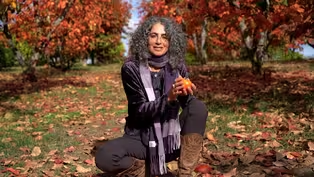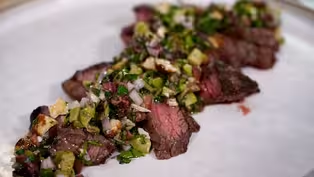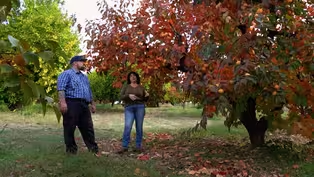
Three Feathers Farm
Clip: 8/30/2024 | 4m 30sVideo has Closed Captions
See why it takes a lot of trial and error to start a small farm in California these days.
See what it takes to start a small farm in California. These two farmers share their ups and downs, and why they have a passion for growing culturally-relevant produce.
Problems playing video? | Closed Captioning Feedback
Problems playing video? | Closed Captioning Feedback
America's Heartland is presented by your local public television station.
Funding for America’s Heartland is provided by US Soy, Sustainable Agriculture Research and Education, Rural Development Partners, and a Specialty Crop Grant from the California Department of Food and Agriculture.

Three Feathers Farm
Clip: 8/30/2024 | 4m 30sVideo has Closed Captions
See what it takes to start a small farm in California. These two farmers share their ups and downs, and why they have a passion for growing culturally-relevant produce.
Problems playing video? | Closed Captioning Feedback
How to Watch America's Heartland
America's Heartland is available to stream on pbs.org and the free PBS App, available on iPhone, Apple TV, Android TV, Android smartphones, Amazon Fire TV, Amazon Fire Tablet, Roku, Samsung Smart TV, and Vizio.
Providing Support for PBS.org
Learn Moreabout PBS online sponsorship(gentle music) - Now what happened here on our tomatoes is essentially we had an overabundance of tomatoes.
- Yep right, mistakes.
- [Narrator] Dilip Sharma and Hektor Calderon's farm is very small, just two acres.
So the challenges and setbacks for these first time growers are a sort of microcosm for what millions of bigger farmers across the US deal with every day, every year.
- Everyone has tomatoes and the challenge of farming is we can't sell everything we grow.
So that's what we are looking at here.
- [Narrator] This year they planted too many tomato varieties too late in the season.
They battled weeds, prices fell, and there was an early frost.
Tomatoes couldn't be sold and got left on the vine.
Lessons learned and they hope applied to next season.
- The focus should be all right, so I figured out this is a problem this year.
So next year how we'll approach it differently.
How are we gonna farm different?
So we are innovating or we are experimenting and we are adapting, we're changing.
- [Narrator] Learning from mistakes, trying new things.
Innovation is the essence of American ingenuity and agriculture.
Innovation and ingenuity are what these two farmers share.
Dilip from his other job in high tech, Hektor from many years working as both a farm hand and farm organizer helping diverse growers start their own farms.
- There are different types of producers.
There's Black and natives and Indians and Mexicans and Vietnamese folks who are producing our food daily and are making these very much so amazing types of crops that sometimes aren't really showcased.
- [Narrator] And showcasing those unique crops is what Three Feathers Farm is all about.
In the field, Dilip and Hektor are harvesting curly and dino kale and broccolini.
Here in the greenhouse, they're gathering seeds from test plots, everything from bitter gorge to frog melon, specialty crops that are favorites in the Indian and Mexican cultures that are part of Dilip and Hektor's heritage.
- And next year we are hoping to plant them and grow and be able to sell it a community.
It'll be a produce a community can enjoy.
- [Narrator] But selling culturally relevant crops to their own communities is just part of the goal.
Dilip and Hektor want consumers from all backgrounds to discover their bounty of organic products.
One way is at farmer's markets, but they're also working closely with local farm to table restaurants like Mohi in the nearby town of Morgan Hill.
- One of the number one, almost like cornerstones of this restaurant is we want to be part of community.
And community means supporting other members in that community.
Whatever we can do to help these local farmers, we're gonna be there to lend a hand.
- I think that makes sense then.
- Yeah, we should dry farm just to do the experimentation thing.
- [Narrator] A modest farm perhaps.
But the two men who work this land have big goals and dreams to connect with the many diverse communities here, to grow sustainably, and to help both underserved and mainstream consumers experience the fruits of their labor.
- The big takeaway here for folks to hear is that we exist, this is a viable business and it can be as long as you put the effort and you really lean on the community that you are hoping to foster and cultivate here.
- There has to be more of a story behind where our food's coming from and who we wanna work with.
And I know that these are the stories that our guests love to hear.
- And I hope in long term my children will look to farming as an option.
I feel like the generation has lost a connection to food, the connection to the land, connection to the farmers, connection to the mother earth.
But that's something I want to instill in my children that, look, this is where the food comes from.
We've gotta take care of the land.
(warm music)
Persimmons - Harvesting Health
Video has Closed Captions
Clip: 8/30/2024 | 3m 43s | Our health expert unpacks all the nutritional benefits of persimmons. (3m 43s)
Seared Skirt Steak by Farm to Fork
Video has Closed Captions
Clip: 8/30/2024 | 5m 24s | Discover how to cook a perfectly seared skirt steak with an olive tapenade. (5m 24s)
Video has Closed Captions
Clip: 8/30/2024 | 5m 41s | Visit a persimmon farm owned by a family that’s been growing this golden fruit for a century. (5m 41s)
Providing Support for PBS.org
Learn Moreabout PBS online sponsorship
- Food
Lidia Celebrates America
Lidia Bastianich honors America’s volunteers, revealing how giving back unites and uplifts.













Support for PBS provided by:
America's Heartland is presented by your local public television station.
Funding for America’s Heartland is provided by US Soy, Sustainable Agriculture Research and Education, Rural Development Partners, and a Specialty Crop Grant from the California Department of Food and Agriculture.



